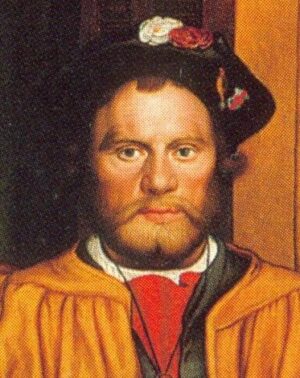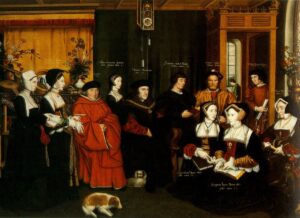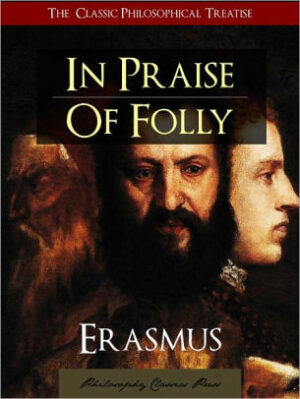
As true to life as the Sola Busca, bagpipe-playing fool appears to be, with their chunky calves and barrel-like chest, they may come across, pinned to this network of signifiers that we call the Tarot, like an illustration of an idea, or a concept, rather than an embodied, felt entity. It is hard to get a sense of the inner life of this 500 year old fool, to feel into the even more ancient archetype, stretching back to a point before we even thought of ourselves as human, but this is something I would like to do here as much as explicate the figure as is often done on Tarot websites.
To feel into the fool, we might look at the image of another human animal, one painted just a few decades after the Sola Busca pack came into being, and with it that other fool I explored in the first episode or track of my Foolish LP. LP, as in Long Player (if I can keep to it, this podcast may last a lifetime), but also perhaps denoting a Libertarian Project, a Lackadaisical Performance, or a Loose Pursuit.
The fool in this episode was drawn and painted by Hans Holbein The Younger. The original painting was destroyed in a fire in 1752, but we (or rather the Kunstmuseum in Basel) still hold some of the pencil studies that Holbein drew for his family portrait of Sir Thomas More, Chancellor of England.
The portrait commissioned on the occasion of More’s 50th birthday. Perhaps I feel drawn to, even obsessed by this image, because in June of this year I too racked up half a century, an age where one starts to plan for a Fool’s journey or project, an age where one is not quite old enough to be a senile old fool, where one can still listen to Silk Sonic and dance deliriously on a grey shagpile carpet, but also an age where one is almost (on a good day) emancipated from certain elements of youthful idiocy that might dog our heels like a yappy chihuahua.
In the drawing of Sir Thomas More’s family, everyone is looking away from us, as well as averting their eyes from each other, but one figure looks directly at the artist, and through him, through time and circumstance, to us the viewer with a calm, but also undaunted look on their face. As if to say: take what you want from me, I am as open as one of these many illustrious and heavy books in this learned man’s house.
We might even translate the expression on his face into modern psychological parlance as something like: I too, like you, am disturbed or discomforted at times by these shadowy, unprocessed elements of my psyche, but I try not shy away from them, from my inner world, that inner world of shadow, of soul, all held and configured in some way by the collective unconscious, which may be thought of even more simply as Our Culture (family, tribal, global), and how it manifests inside and around us in ways that shape our perceptions, experiences, ideas and even more painfully, those tyrannical ideals that we hold ourselves accountable to. Who or what we might become in the social milieu of Our Culture, what sort of role or persona we might wish to play or pursue, all of those yearned for mutations and transfigurations.
Who is this figure who looks out from that lost painting? It is nobody, like all of us. We are all nobodies, even when named and assigned a position in our social worlds. Which is to say: we are at all times unbodied selves, egos personalities, created out of language and narrative.
This nobody is called Henry Patenson and he is Thomas More’s fool, who perhaps because he is not shy at holding our gaze, seems to jump across time to meet us in a way that all the other fools in this painting can’t or won’t.
This is the special perogative of the fool I think, to consciously, meta-cognitively stand outside the frame of any given situation, ideological or epistemological, to stand to one side of our culture’s certainties and self-bolstering assumptions, and to express, like the child who called out when the naked emperor walked past “What the!?”.
Or even better, as the wise child Gary Coleman, in a beloved TV sitcom of my youth, would at some point in every episode say: “What you talking about Willis” What you talking about Boris? What you talking about you climate catastrophe deniers. What you talking about anti-vaxxers? What the [beep] are you talking about? And even more so: why?
 Everyone else in this painting can be understood as inhabiting a persona: the word taken directly from the Latin by Carl Jung in the early years of the last century, as he grappled with his understanding of the animal human psyche, his own and that of others. It refers, as you may know, to masks worn by “actors in antiquity”. Our persona is how we present to the Outer World as Jung called it: all our interactions with others in the flesh or more likely nowadays, as avatars in the metaverse of social media. There is little felt, inner presence to this experience, we are absent somehow when we inhabit a persona, we fuse with and into its function and force.
Everyone else in this painting can be understood as inhabiting a persona: the word taken directly from the Latin by Carl Jung in the early years of the last century, as he grappled with his understanding of the animal human psyche, his own and that of others. It refers, as you may know, to masks worn by “actors in antiquity”. Our persona is how we present to the Outer World as Jung called it: all our interactions with others in the flesh or more likely nowadays, as avatars in the metaverse of social media. There is little felt, inner presence to this experience, we are absent somehow when we inhabit a persona, we fuse with and into its function and force.
“The persona is exclusively concerned with the relation to objects.” writes Jung in his 1921 book Psychological types. “The relation of the individual to the object must be sharply distinguished from the relation to the subject. By the “subject” I mean first of all those vague, dim stirrings, feelings, thoughts, and sensations which flow in on us not from any demonstrable continuity of conscious experience of the object, but well up like a disturbing, inhibiting, or at times helpful, influence from the dark inner depths, from the background and underground vaults of consciousness, and constitute, in their totality, our perception of the life of the unconscious.”
We see this being played out in the Holbein painting. For around this historical fool, Henry Patenson, we have Thomas More’s family all playing some version of themselves. For example: Margaret Roper, the chancellor’s oldest and brainiest daughter is, true to type, sitting with a book on her lap. Dame Alice, More’s second wife, is also reading a book behind her. Maybe More and/or the artist found women reading a turn-on or a signifier for virtue. If this was a modern portrait of the great and the good, they would probably be looking at their phones. It is only Henry Patenson, More’s fool who seems fully present, fully inhabiting his body, who looks at Holbein, Hans, Henry meeting the gaze of Hans the artist, also in the employ of Thomas More, as another subject rather than as an object.
It was not uncommon for the great and the good of that era to have such a figure in their employ. The fool’s role in domains of power, writes John Southworth in his book Fools and Jesters, “may be as old as kingship itself”.
The ‘trickster’ figure that anthropologists have identified in ancient myths and legends, the chaos-makers and sower of discord, who frighten the hell out of us, but also appeal in their vitality and creativity, might at some point become bound and contained in a mutually advantageous partnership with a tribal chieftain or king; advantageous to the ruler because they provide him with necessary recreation (fools could often play musical instruments, sing, tell stories and jokes) but also, because the fool possesses little social capital themselves, they are not vying for status like everyone else, they are nothing but that form in which they manifest moment to moment, having through circumstance or by conscious choice, stepped out of zero sum game of status and the being of a somebody which seems at times to be the only glue that holds the human animal species together. One’s personal fool might also bring to the ruler’s attention gossip and plots against their master overheard from other courtiers. We see this strikingly and incredibly movingly in Shakespeare’s King Lear and in Lear’s co-dependent relationship with his wise fool.
If you were a king, or in the case of More, the The Lord Chancellor of England, the rituals and obligations of your position would not necessarily make it easy to enjoy or benefit from the humour and companionship of another’s intimate inner world, the inner world of the human animal. For everyone around you would be a fleshy avatar of sorts, mainly inhabiting the performance of persona.
Only a fool might be able to relate to Sir Thomas More as another animal human, and also as someone who can always see beyond the masks we tend to wear in public and often in private. I first experienced what it felt like to inhabit this position as a fool when in my early 20s I taught one-to-one business English (I have no idea how this came about, I knew nothing of business having studied English Literature at university) to politicians and various other commercial bigwigs in Milan and Rome. These men (and they were unfortunately men for the most part) enjoyed being able to say things to me, to confide in me about their family or work struggles, in a foreign tongue which made their confessions seem somehow less real to them, and so maybe less shameful. You might say, as a psychotherapist, I am still playing this role thirty years on.
In our own age, intensely saturated with masks (social media is almost nothing but masks) the fool joins the ranks of certains kinds of therapists or healers, of comedians, as well as creatives of various hues, and yes even tarot card readers or anyone who still exists in that liminal space where a psychic messenger might be required carry some form of communication from the inner world to the surface, from esoteric to exoteric, from magical or mystical to the mundane, maybe giving voice something that we’re all thinking but dare not put our masks aside to utter.
In the last two years, we have all experienced how uncomfortable, claustrophobic and glasses-befogging it is to wear these outer masks all the time. I am practically blind in the winter when I walk around in my surgical blue polypropylene muzzle – imagine having to wear such a thing, in the shape of a persona all day long? Which of course is mostly how we experience ourselves and each other. As persona-lities. Hard to let go of our persona-lities, or get beyond someone else’s. At some level, maybe even impossible.
Henry Patenson, unlike his master Thomas More, didn’t leave any account of himself. But perhaps his spirit was captured by More’s friend, the Dutch humanist Desiderius Erasmus, who would often shoot the breeze with Patenson when Erasmus was given permanent rooms in the Old Barge on the Thames side in Bucklersbury, More’s home for the first two decades of his married life.
 It is here that the young Erasmus wrote his masterpiece In Praise of Folly. I’d never read the book, even though I’d often read of it whilst doing my term of renaissance studies at University. Recently I listened to In Praise of Folly as an audiobook, and I’m glad I did for it comes across, I kid you not, as an early Renaissance Netflix Comedy Special. If you’re a fan of Bill Hicks, or Nish Kumar, Frankie Boyle, Hannah Gadsby, Schumer, Wong, Silverman, anyone with a bit of bite, you will dig In Praise of Folly, although it does at times wear its 15th century misogyny on its sleeve like dried vomit on a denim jacket.
It is here that the young Erasmus wrote his masterpiece In Praise of Folly. I’d never read the book, even though I’d often read of it whilst doing my term of renaissance studies at University. Recently I listened to In Praise of Folly as an audiobook, and I’m glad I did for it comes across, I kid you not, as an early Renaissance Netflix Comedy Special. If you’re a fan of Bill Hicks, or Nish Kumar, Frankie Boyle, Hannah Gadsby, Schumer, Wong, Silverman, anyone with a bit of bite, you will dig In Praise of Folly, although it does at times wear its 15th century misogyny on its sleeve like dried vomit on a denim jacket.
In Praise of Folly is the very best kind of stand-up, interrogating the fakery and hypocrisies of it day, with broad-brush satire, as well as a delicious childlike transparency, pointing as if often does to the emperors and politicians inner shadowy worlds, pointing out that they too, in the sanctum of their minds and hearts, are naked, vulnerable, flawed creatures covered with nothing but the apparel and attire, the modes and methods of language, this language here, which uses us even more than we pretend to use it.
Erasmus’s humour, perhaps modelled on Patenson himself, although Folly (cue the misogyny) is imagined as a woman rather than a man, is leavened by shrewd and sagacious insights, elegantly mirroring the folly of our own age and probably of every idiotic animal human age, reminding us once more why the fool, an uncounted, uncountable zero, a nobody, standing apart from the world by dint of class or circumstance, or just sheer bloody-minded otherness, is somehow able to see more deeply into our experience of being and of consciousness.
The curious double-act of king and fool, master and servant, self and shadow, may also be seen as a universal, symbolic expression of the antithesis lying at the heart of an autocratic state, or an autocratic psychic system, run as we now fully understand it to be configured according to libidinal drives, status-driven politicking, and even more so the business of feeling of control through social or financial assets. The fool on his tiny unicycle teeters between the forces of order and disorder, of structured authority and incipient anarchy, in which the conditional nature of the his status (‘so far but no further’) gives reassurance that ultimately order will always prevail.
Eternal underdog as he is, constrained as he is, he also continually threatens to break free of whatever structure he finds himself in, pushing that often phantasmagorical structure, created out of language and thought, to it limits, in order to arrive at whatever freedom he might find therein or outside of it. He is the the Dionysian trickster of myth in a historical strait-jacket from which he is forever struggling to escape. I can very much relate to this double bind, how about you?
